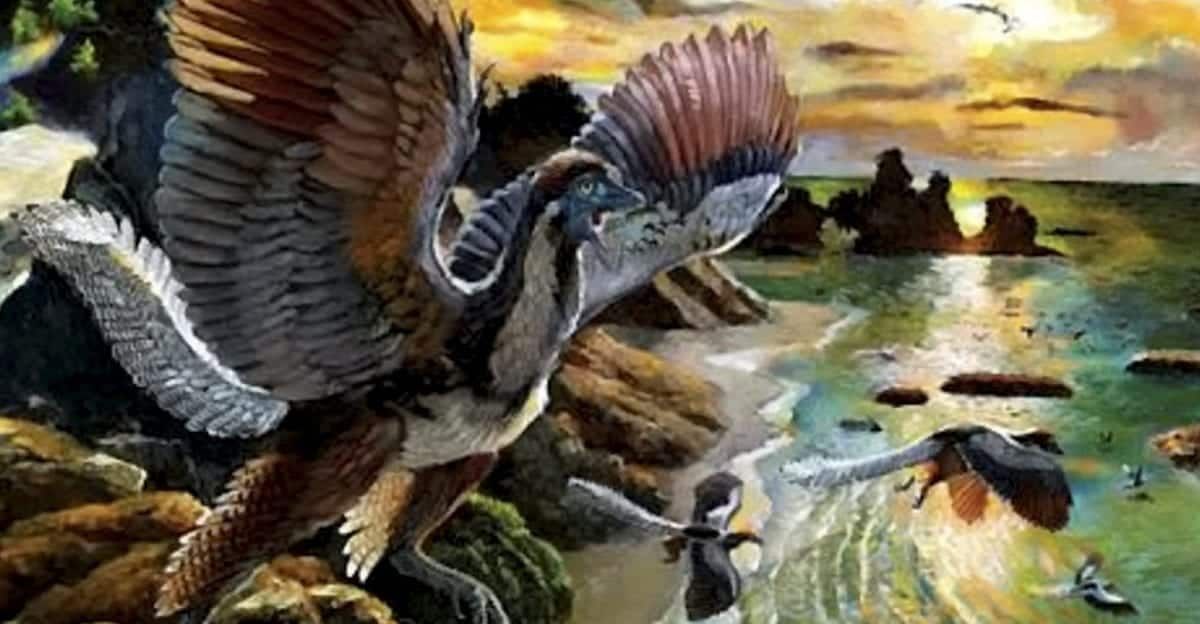
Archaeopteryx, one of the most famous fossils ever discovered, really was the world’s first bird, say scientists.
A new species has been uncovered that confirms its status as the ‘missing ‘link’ between dinosaurs and our feathered friends.
Named Archaeopteryx albersdoerferi, it was able to fly thanks to thin air filled bones that we see in birds today.
This shows the winged creature that soared through the Jurassic skies 150 million years ago was a “transitional” animal – and not a ‘dead end’.
It must have developed these avian traits over time, explained palaeontologist Professor Martin Kundrat.
The study published in journal Historical Biology said Archaeopteryx can now be conclusively considered to be a primitive ancestor of birds.
Its teeth and clawed fingers prove it is an evolutionary intermediate between birds and dinosaurs.
Some experts have insisted Archaeopteryx was just another feathered dinosaur.
But the analysis by Prof Kundrat and colleagues proves this is not the case.
They used a state-of-the-art 3D X-ray scanning technique called Synchrotron microtomography to virtually dissect the fossil.
This identified for the first time the skeletal adaptations that would have helped Archaeopteryx albersdoerferi to fly.
About the size of a raven, its fossil was made available to the team for the unique study that took more than seven years to recognise it as a new species.
Lead author Prof Martin Kundrat, from the University of Pavol Jozef Safarik, Slovakia, said: “Archaeopteryx albersdoerferi is one of the most important specimens of Archaeopteryx because it is around 400,000 years younger than any of the others found so far.
“This is the first time that numerous bones and teeth of Archaeopteryx were viewed from all aspects including exposure of their inner structure.
“The use of synchrotron microtomography was the only way to study the specimen as it is heavily compressed with many fragmented bones partly or completely hidden in limestone.”
The fossil was discovered in a quarry near Daiting in southern Germany in 1990 – but had never been examined before.
It contains most of the skull, along with parts of the shoulders and left wing. It is encased in rock and has been squashed, But Prof Kundrat had high-powered X-rays.
He said: “We can see every preserved bone. Not only that, we can see these bones from inside.”
The team found subtle differences in the bones and teeth not seen in the other known fossils of Archaeopteryx.
Some of the bones are hollow, which makes them lighter. Modern birds have similar bones.
Being the oldest Archaeopteryx specimen provides the most accurate insight to date into Archaeopteryx’s late evolutionary history.
When the team built a new family tree of birds and related dinosaurs, it placed the new species of Archaeopteryx at the base of the bird line.
Prof Kundrat said: “It’s in an important position to tell us about the early evolution of avian dinosaurs.”
Archaeopteryx means “ancient wing”. The first fossil skeleton was unearthed in Germany in 1861 and is housed at London’s Natural History Museum.
Due to sharing characteristics of dinosaurs and birds – including wings, sharp teeth, claws and a long bony tail – its place on the evolutionary tree has been debated for over 150 years.
Prof Per Ahlberg, of Uppsala University, Sweden, said: “Our analysis has shown Archaeopteryx albersdoerferi shares more features in common with modern birds than their dinosaurian ancestors.”
These traits suggest it may have possessed enhanced flying ability relative to geologically older species of Archaeopteryx.
The most remarkable included thin air-filled bones, increased area for attachment of flight muscles on the wishbone and a reinforced configuration of bones in the wrist and hand.
Archaeopteryx albersdoerferi also had fused bones in the skull and fewer teeth than other species of these ‘first birds’.
Dr Benjamin Kear, also of Uppsala University, said: “Significantly, however, when we examined the evolutionary relationships of various species of Archaeopteryx we found its flight-related characteristics had appeared separately from those of more advanced bird-line dinosaurs, implying that flying lifestyles have developed more than once.”
When Archaeopteryx was first found it was immediately seized on as evidence for Darwin’s theory of evolution.
It may have had black feathers. It has been suggested it only flew in short bursts like a pheasant, and hunted at night.
But over the last decade its position has been called into question, following the discovery of similar dino-birds in China.
A 2011 study built a family tree and concluded that Archaeopteryx was a dinosaur, not a bird.
Added Prof Kundrat: “The specimen exhibits a mosaic accumulation of flight-supporting morphologies before it reached adulthood.
“Whether this trend is applicable for other basal birds, it will need to be studied when more virtual data are available.”
Ultimately, the findings have uncovered a possible evolutionary mechanism through which flight-supporting characteristics developed during the evolution of dinosaurs.
Archaeopteryx, in particular, independently acquired increasingly bird-like traits over time, said the researchers.
A dozen specimens of Archaeopteryx have been recovered to date. The fossil in this study was the most mysterious.
For years it was held in private ownership and and was nicknamed ‘the Phantom’, until in 2009 palaeontologist Raimund Albersdorfer bought it.
It is now on long-term loan to the Bavarian State Collection of Palaeontology and Geology in Munich.